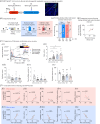Comparing behaviours induced by natural memory retrieval and optogenetic reactivation of an engram ensemble in mice
- PMID: 38853560
- PMCID: PMC11343273
- DOI: 10.1098/rstb.2023.0227
Comparing behaviours induced by natural memory retrieval and optogenetic reactivation of an engram ensemble in mice
Abstract
Memories are thought to be stored within sparse collections of neurons known as engram ensembles. Neurons active during a training episode are allocated to an engram ensemble ('engram neurons'). Memory retrieval is initiated by external sensory or internal cues present at the time of training reactivating engram neurons. Interestingly, optogenetic reactivation of engram ensemble neurons alone in the absence of external sensory cues is sufficient to induce behaviour consistent with memory retrieval in mice. However, there may exist differences between the behaviours induced by natural retrieval cues or artificial engram reactivation. Here, we compared two defensive behaviours (freezing and the syllable structure of ultrasonic vocalizations, USVs) induced by sensory cues present at training (natural memory retrieval) and optogenetic engram ensemble reactivation (artificial memory retrieval) in a threat conditioning paradigm in the same mice. During natural memory recall, we observed a strong positive correlation between freezing levels and distinct USV syllable features (characterized by an unsupervised algorithm, MUPET (Mouse Ultrasonic Profile ExTraction)). Moreover, we observed strikingly similar behavioural profiles in terms of freezing and USV characteristics between natural memory recall and artificial memory recall in the absence of sensory retrieval cues. Although our analysis focused on two behavioural measures of threat memory (freezing and USV characteristics), these results underscore the similarities between threat memory recall triggered naturally and through optogenetic reactivation of engram ensembles. This article is part of a discussion meeting issue 'Long-term potentiation: 50 years on'.
Keywords: amygdala; engram; mouse; optogenetic reactivation; threat memory; ultrasonic vocalizations.
Conflict of interest statement
We declare we have no competing interests.
Figures

Similar articles
-
Short-Term Memory Impairment.2024 Jun 8. In: StatPearls [Internet]. Treasure Island (FL): StatPearls Publishing; 2025 Jan–. 2024 Jun 8. In: StatPearls [Internet]. Treasure Island (FL): StatPearls Publishing; 2025 Jan–. PMID: 31424720 Free Books & Documents.
-
Anterior basolateral amygdala neurons comprise a remote fear memory engram.Front Neural Circuits. 2023 Apr 27;17:1167825. doi: 10.3389/fncir.2023.1167825. eCollection 2023. Front Neural Circuits. 2023. PMID: 37180762 Free PMC article.
-
Amnesia after Repeated Head Impact Is Caused by Impaired Synaptic Plasticity in the Memory Engram.J Neurosci. 2024 Feb 21;44(8):e1560232024. doi: 10.1523/JNEUROSCI.1560-23.2024. J Neurosci. 2024. PMID: 38228367 Free PMC article.
-
Psychological interventions for adults who have sexually offended or are at risk of offending.Cochrane Database Syst Rev. 2012 Dec 12;12(12):CD007507. doi: 10.1002/14651858.CD007507.pub2. Cochrane Database Syst Rev. 2012. PMID: 23235646 Free PMC article.
-
Technological aids for the rehabilitation of memory and executive functioning in children and adolescents with acquired brain injury.Cochrane Database Syst Rev. 2016 Jul 1;7(7):CD011020. doi: 10.1002/14651858.CD011020.pub2. Cochrane Database Syst Rev. 2016. PMID: 27364851 Free PMC article.
Cited by
-
Long-term potentiation: 50 years on: past, present and future.Philos Trans R Soc Lond B Biol Sci. 2024 Jul 29;379(1906):20230218. doi: 10.1098/rstb.2023.0218. Epub 2024 Jun 10. Philos Trans R Soc Lond B Biol Sci. 2024. PMID: 38853569 Free PMC article.
-
Memory engram synapse 3D molecular architecture visualized by cryoCLEM-guided cryoET.bioRxiv [Preprint]. 2025 Jan 12:2025.01.09.632151. doi: 10.1101/2025.01.09.632151. bioRxiv. 2025. PMID: 39829918 Free PMC article. Preprint.
References
-
- Schacter DL. 1982. Stranger behind the Engram: theories of memory and the psychology. Hillsdale, NJ: Erlbaum Associates.
MeSH terms
Grants and funding
LinkOut - more resources
Full Text Sources

